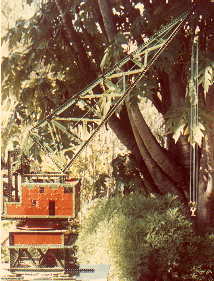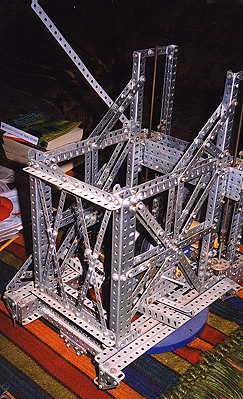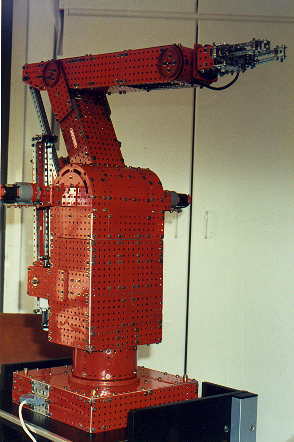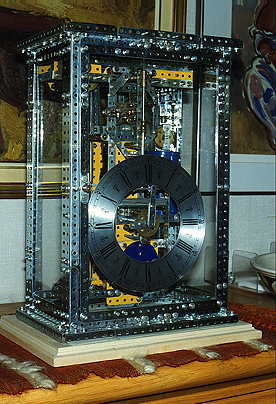

by Michael Adler
Meccano has been a lifetime hobby. It has been a source of pleasure, a fascination and a constant challenge. Here, in my box is a collection of parts, which can be moulded into a model. No special tools required. There are prototypes everywhere, and one builds whatever one finds interesting. It all started in 50 years ago in a Meccano Boys Club, with an inspiring leader, Mr de Beer, who will never know the debt I owe him for his painstaking attention to my first efforts. How much I admired his block-setter, trench digger, and all the other wonderful models he produced. And he instilled a love for Meccano which has lasted to this day.
This is a small selection of some of my models. The first is a beautiful Dockside Crane which I built as a small boy. It was radio controlled from a single channel. I have always wanted to return to this model, as I think of it as my personal block-setter, and it would be a tremendous challenge to bring it to reality one day. You can see how its modern counterpart is taking shape.
|
 |

The industrial robot has always fascinated me, ever since I went to a Robotics exhibition in Ghent, Belgium in 1983. As soon as I walked into the display, I knew that I had to build one! I had one working six weeks after returning home, such was my drive and determination. It eventually became a ModelPlan, and is now on permanent exhibition at Geoff Wrights famous Meccano shop at MW Models, Henley on Thames, England, patiently waiting perhaps for the day when she will respond to computer commands. |
I have always been interested in clocks, and was perhaps most inspired by the story of the search for a clock that could keep the time at sea. You can read this story in Dava Sobel's marvellous book, 'Longitude'. For it is longitude you see that is a function of time. And it was the lack of an accurate timepiece that forced sailors unremittingly off course and onto the rocks.

The British Admiralty was determined to find a way to measure time at sea, and so a Board of Longitude was constituted in 1725, with prize money of twenty five thousand pounds going to the inventor. This was serious money in those days. John Harrison produced a clock some years later. It was carefully examined in London, and it took Harrison all his life and many more clocks to convince the Board of the accuracy of his clocks under the extremely adverse conditions of a sea voyage. His first Navigation clock is shown here, and is on permanent exhibition at the Royal Observatory, Greenwich.

That clock became the inspiration for the famous British clockmakers, Sinclair Harding, to produce their own version of the clock, with its unique grasshopper escapement. That clock in turn inspired me to build my own version, and it won the coveted Issigonis Shield at Skegness in 1989.
I went on to build other clocks. Meccano lends itself to clock-making. In a strange way, it allows experimentation with gears and detentes and other strange beasts of the clockmakers art. No lathe in sight, no workshop, no tools other than screwdriver and spanner. And Meccano clocks are not models. They are the real thing. Clocks.
 Here is an example of
clock-making, the grandfather grasshopper escapement long case clock, which also became a
ModelPlan.
Here is an example of
clock-making, the grandfather grasshopper escapement long case clock, which also became a
ModelPlan.
| In the last few years, another clock was produced. I bought a book on clocks 'My Own Right Time' by Paul Woodward at the British Model Engineering Exhibition at Earls Court in 1996. I saw a drawing of a unique mechanism, and knew that I had to attempt it in Meccano. It was the Arnfield Detached Gravity Escapement. That clock also became a ModelPlan, and gave me very great pleasure. It is a highly accurate timepiece |  |

My last model, is altogether on a different subject. Those who have been to sea may remember the old Liberty Ships of which thousands were built during the second word war. They were powered by an outdated but unique triple expansion steam engine, which was accepted as the power plant for this vessel, because it could be mass produced by relatively unskilled artisans. They lived up to their reputation, and steamed thousands of miles alone and in convoys all over the world, and were still in service long after the war ended. Anyone who has been to the Science Museum in London will have seen such an engine on display. It is a marvellous piece of balanced machinery in motion, and I just had to try my hand at it. Here you see my representation of that model, and yes, you guessed it, it became a ModelPlan!
Michael Adler - May 1999
|